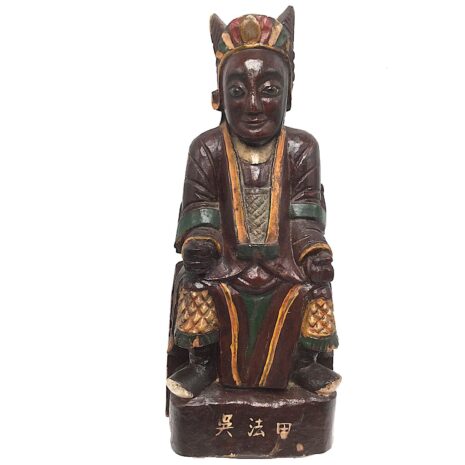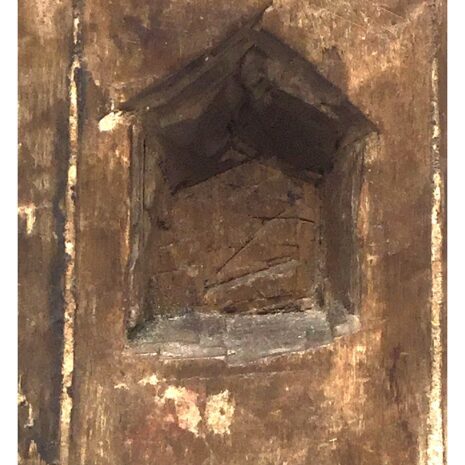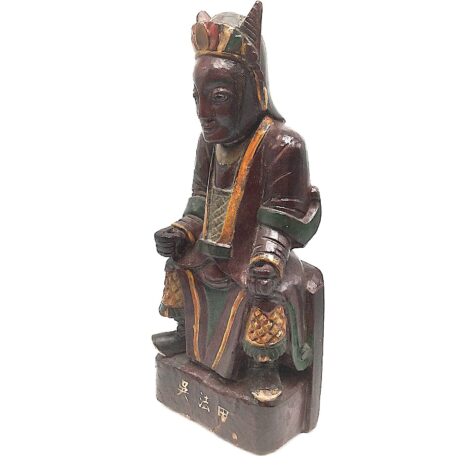Antique Carved House Deity or Ancestor Figure, China (7507)
Original price was: $325.00.$275.00Current price is: $275.00.
H: 12.75″ W: 3.375″ D: 3″ | FREE SHIPPING WITHIN CONTINENTAL U.S.
Either a Taoist house deity/dignitary or an ancestor figure, this colorful provincial carving has painted calligraphy identifying his name. The image has characteristics of Guandi, the God of War holding a tael or a military seal with military maille.
Description
Most Chinese houses had a home altar or shrine with Taoist and/or Buddhist images, legendary and historical figures/deities from popular religions, and ancestor images. Depending on family wealth, the altar/shrine included ancestor tablets (also called memorial or spirit tablets), papers memorializing ancestors, and ancestor paintings on the wall.
The diversity of deities and ancestors dressed as officials, priests, and ancestors was large, and, as many gods were local and confined to specific locations, identifying them is problematic when out of context, without specific iconographical features, or when they are not accompanied by Chinese script naming them. (Stevens, p. 20-27)
This colorful carving is either a Taoist house deity/dignitary or an ancestor figure. The calligraphy painted on the base names him “吳法甲” (Wu Fajia) presumably the ancestor to whom the statue is dedicated. Provincial carvers occasionally created their own versions of deified figures by merging characteristics from several gods into a single figure. This image has characteristics of Guandi, the God of War a popular figure in Chinese folk religion, Taoism, Confucianism, and Buddhism. Seated on a high backless chair, hands on the knees, one holds a small object like a tael (symbol of wealth) or a military seal, the other is poised to hold a sword, and he wears military maille at the chest and knees.
The piece is unique as it has two rear carved cavities to hold consecration slips or ritual items in an eye-opening ceremony by a Taoist priest. The upper rectangular cavity is sealed with a cover bung, while the lower one is open with a pitched tops shaped like a temple. The wood statue is finished with polychrome paint and lacquer, some of which has worn away over time and is in excellent condition
Sources:
Brock Silvers, The Taoist Manual: An Illustrated Guide, Applying Taoism to Daily Life, Honolulu, Sacred Mountain Press, 2005.
Keith Stevens, Chinese Gods; the Unseen World of Spirits and Demons, London, Collina and Brown Limited, 1997.
The Art Institute of Chicago, The Taoist Renaissance, 2000. http://www.artic.edu/taoism/renaissance/introi.php
Click here for Eye-Opening Consecration Ceremony Blog.
Additional information
| Weight | 5 lbs |
|---|---|
| Dimensions | 12 × 9 × 6 in |
| Place of Origin | China |
| Period | Antique/Vintage (1910-1980) |
| Date | 1920-1940 |
| Materials and Technique | Wood |
| Dimensions (inches) | Ht: 12.75” W: 3.375” D: 3” |
| Dimensions (metric) | Ht: 32.38cm W: 8.57cm D: 7.62cm |
| Weight | 1lb 11oz |
| Condition | Excellent, See Descripton |
| Item Number | 7507QOK |
| Shipping Box Size |










